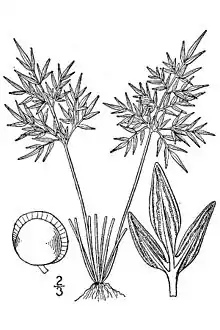Aspidotis
Aspidotis is a small genus of leptosporangiate ferns known commonly as laceferns. Most species are native to slopes, ridges, and rocky outcroppings, primarily in California and Mexico,[1] although one species included in the genus by some authorities is widely distributed in eastern Africa.[2]
| Aspidotis | |
|---|---|
 | |
| Aspidotis densa | |
| Scientific classification | |
| Kingdom: | Plantae |
| Clade: | Tracheophytes |
| Class: | Polypodiopsida |
| Order: | Polypodiales |
| Family: | Pteridaceae |
| Subfamily: | Cheilanthoideae |
| Genus: | Aspidotis (Nutt. ex Hook.) Copel. |
| Species | |
Description
Members of Aspidotis are small ferns, with shiny, tufted fronds generally less than 35 centimeters long (although A. schimperi may be larger[2]). Fertile leaves have false indusia formed by the leaves' inrolled margins, which partially conceal the spore-bearing sori.[1][3]
Taxonomy
The taxonomy of laceferns has been considerably refined since they were first described in the late 1800s. Species currently placed in Aspidotis were originally assigned to a section of Hypolepis, then to Cheilanthes. David Lellinger established Aspidotis as a distinct genus based on characteristic features of its false indusia and its leaves, including their shiny surface,[4] although as late as the 1990 publication of the Kubitzki system, these ferns were sometimes still included in Cheilanthes.[5]
Species
As of January 2020, the Checklist of Ferns and Lycophytes of the World recognized five species,[6] including one identified as a fertile interspecific hybrid.[7]
- Aspidotis californica (Nutt. ex Hook.) Nutt. ex Copel. – California lacefern
- Aspidotis carlotta-halliae (Wagner & E. F. Gilbert) Lellinger – Carlotta Hall's lacefern or tufted lacefern, a fertile hybrid of A. californica and A. densa, endemic to California
- Aspidotis densa (Brack.) Lellinger – cliffbrake or Indian's dream
- Aspidotis meifolia (D.C.Eaton) Pic.Serm. – endemic to Mexico
- Aspidotis schimperi (Kunze) Pic. Serm. – the African species
Other species of plants commonly known as laceferns are not part of Aspidotis and are often not closely related. Microlepia strigosa is from a different order of ferns, and Asparagus setaceus is not a fern at all.
Ecology
Ferns in this genus grow in a variety of conditions, from low woodland slopes,[2] to chaparral, to higher-elevation ridges, to marginal habitats like rocky crevices and the bases of boulders.[1][3]
Some laceferns show an affinity for serpentine soil. In particular, disjunct populations of A. densa in eastern North America are edaphic endemics.[8] A. carlotta-halliae and the West Coast populations of A. densa are commonly associated with these ultramafic soils but are not restricted to them.[9][10]
Etymology
Not all authorities agree on the exact etymology of Aspidotis. In all cases, the name is derived from Greek, and refers to the distinctive shield-like false indusium found especially in A. californica. Some authors suggest ασπιδοτες (shield-bearer)[1] as the intended origin, while others claim ασπιδος-ωτος (shield-eared).[11]
References
- Flora of North America Editorial Committee, ed. (4 Nov 1993). Pteridophytes and Gymnosperms. Flora of North America: North of Mexico. 2. Oxford University Press. pp. 170–171. ISBN 978-0-19-508242-5.
- Beentje, H. J., ed. (1 Jun 2002). Flora of Tropical East Africa - Adiantaceae. A. A. Balkema Publishers. pp. 2–3. ISBN 978-90-5809-410-0.
- Smith, A. Reid (1975). "The Californian species of Aspidotis". Madroño. 23 (1): 15–24.
- Lellinger, David B. (1968). "A Note on Aspidotis". American Fern Journal. 58 (3): 140–141. doi:10.2307/1546553. JSTOR 1546553.
- Kramer, K.U.; Green, P.S.; Kubitzki, K., eds. (Jan 1990). Pteridophytes and Gymnosperms. The Families and Genera of Vascular Plants. 1. Springer. p. 242. ISBN 978-3-540-51794-8.
- Hassler, Michael & Schmitt, Bernd (November 2019). "Oeosporangium". Checklist of Ferns and Lycophytes of the World. 8.11. Retrieved 2020-01-01.
- Wagner Jr., W.H.; Gilbert, Elizabeth F. (Nov 1957). "An Unusual New Cheilanthoid Fern from California". American Journal of Botany. 44 (9): 738–743. doi:10.2307/2438394. JSTOR 2438394.
- Harris, Tanner; Rajakaruna, Nishanta (2009). "Adiantum viridimontanum, Aspidotis densa, Minuartia marcescens, and Symphyotrichum rhiannon: Additional Serpentine Endemics from Eastern North America". Northeastern Naturalist. 16 (sp5): 111–120. doi:10.1656/045.016.0509. S2CID 54871497.
- Howell, John Thomas (Jan–Mar 1960). "The Endemic Pteridophytes of the California Floral Province". American Fern Journal. 50 (1): 15–25. doi:10.2307/1545239. JSTOR 1545239.
- Safford, H. D.; Viers, J. H.; Harrison, S. P. (2005). "Serpentine Endemism in the California Flora: A Database of Serpentine Affinity". Madroño. 52 (4): 222–257. doi:10.3120/0024-9637(2005)52[222:seitcf]2.0.co;2.
- Gledhill, David (17 Mar 2008). The Names of Plants (4th ed.). Cambridge University Press. p. 59. ISBN 978-0-521-86645-3.